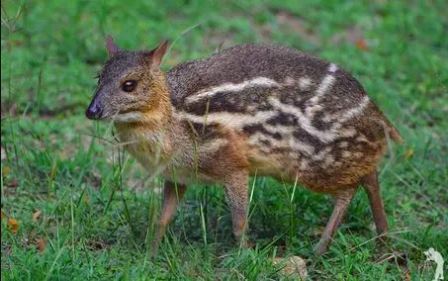Pheromone Play a Role in Reproduction of Mouse Deer
The smallest wild deer has been listed in Schedule I of the Wildlife Protection Act due to frequent hunting for bush meat.
Indian chevrotain or mouse deer plays a significant role in the forest ecosystem as a seed disperser. Though commonly found in forested areas, the smallest wild deer has been listed in Schedule I of the Wildlife Protection Act (1972) due to frequent hunting for bush meat. A group of researchers from the Laboratory for the Conservation of Endangered Species (LaCONES), CSIR-Centre for Cellular and Molecular Biology (CCMB), has discovered the factors that may help in breeding mouse deer.
Though commonly found in forested areas, the smallest wild deer has been listed in Schedule I of the Wildlife Protection Act (1972) due to frequent hunting for bush meat. A group of researchers from the Laboratory for the Conservation of Endangered Species (LaCONES), CSIR-Centre for Cellular and Molecular Biology (CCMB), has discovered the factors that may help in breeding mouse deer.
A conservation breeding and species recovery programme for mouse deer was initiated in 2010 by Nehru Zoological Park, Hyderabad, in collaboration with the LaCONES at CSIR-CCMB, with support from the Central Zoo Authority. The programme started with six individuals (two males and four females) and aimed to increase their numbers in captivity and reintroduce them into the wild.
The researchers, led by Dr G. Umapathy used a non-invasive faecal hormone assay for pheromones, progesterone, and other hormones to study the physiology of more than ten mouse deer in captivity for more than one year at the Hyderabad zoo.
They discovered the occurrence of novel postpartum estrus (the phase where the animal is ready to mate). They found that the female mouse deer shows estrus and mates within 4-6 hours of delivery. This is the shortest postpartum estrus observed so far among large mammals. This finding led to a further study on understanding the reproductive physiology of the mouse deer using non-invasive methods.
“As part of the conservation breeding programme of endangered Mouse Deer, we discovered post-Partum estrus within 4-6 hours of delivery of baby fawn. Mating of the pair was observed within the day of delivery of the baby, which is called postpartum estrus. We studied in captive animals about the phaenomena and discovered postpartum estrus and the presence of a pheromone called 16-Androstenes in mouse deer, ”explained Dr Umapathy, while speaking to India Science Wire.
The team examined the molecular characteristics of the pheromones, their synthesis pathway, and their functions in mouse deer reproduction. “We found that pheromones levels were significantly elevated in the female mousedeer during delivery, postpartum estrus, and mating. We also found a positive correlation between pheromones and estrogens one week before post-partum estrus and mating. Our findings have already helped in breeding mouse deer at the Nehru Zoological Park but will also help other Indian zoos and elsewhere,” said Dr Umapathy.
Understanding the reproductive biology of animals is most important before starting a conservation breeding or species recovery programme. The new study suggests that the zoo authority should keep a male with late pregnant females for mating immediately after delivery. The method assisted in successfully breeding mouse deer from 6 to 300 individuals.
Apart from Dr G. Umapathy, the research team included Vinod Kumar, Manu Shivakumara, Caroline Karunakaran, Anupama Sekhar (all from CCMB); Mamta Sajwan-Khatri (Department of Animal Biology, School of Life Sciences, University of Hyderabad); Sandeep Mushkam (Nehru Zoological Park); Wasimuddin (CCMB); and Senthilkumaran Balasubramanian (Department of Animal Biology, School of Life Sciences, University of Hyderabad).
The research study has been published in Cells, an open-access journal of MDPI. (India Science Wire)
